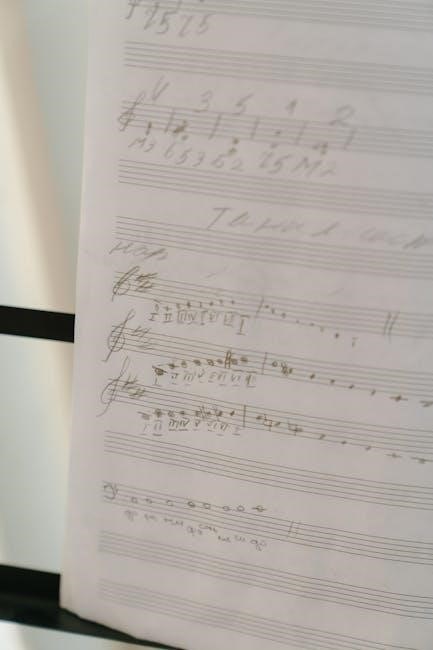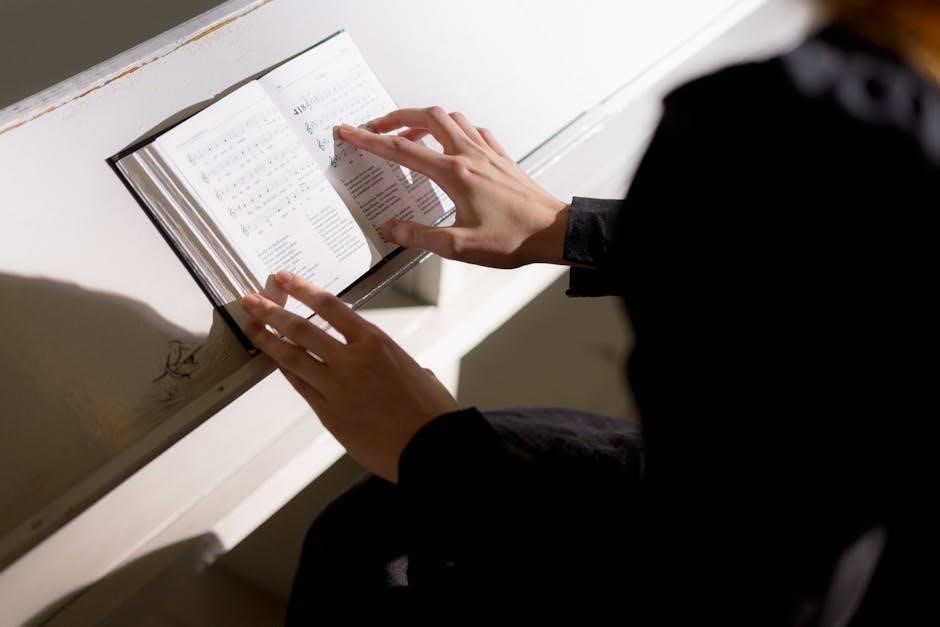Overview of “Misty” Sheet Music
The sheet music for “Misty,” a jazz standard by Erroll Garner, is widely available. Resources range from free PDF downloads to paid arrangements for various instruments, providing options for musicians of all levels.

Erroll Garner: The Composer of “Misty”
Erroll Garner, a self-taught jazz pianist with a distinctive style, composed “Misty” in 1954. Initially an instrumental piece, it showcased Garner’s improvisational skills and harmonic sophistication. Garner’s unique approach to the piano, characterized by his use of block chords and a buoyant rhythmic feel, is evident in the composition’s structure.
Garner first recorded “Misty” for his 1955 album “Contrasts.” The original instrumental version quickly gained popularity among jazz musicians. It became a vehicle for improvisation and a testament to Garner’s melodic gift. His composition, following a 32-bar format, provided a solid foundation for other musicians to explore and interpret the song, solidifying his legacy.

“Misty” as a Jazz Standard
“Misty” quickly ascended to the status of a jazz standard, embraced by musicians across genres for its beautiful melody and harmonic richness. Its 32-bar structure made it ideal for improvisation, allowing countless artists to put their unique stamp on the tune. The song’s inherent versatility allowed it to be adapted to various instrumental settings.
The song’s popularity led to its inclusion in numerous jazzReal Books and sheet music collections, further cementing its place in the jazz canon. Its enduring appeal lies in its ability to evoke a sense of romance and nostalgia, making it a favorite among both performers and audiences. “Misty’s” presence is a testament to its timeless quality and its power to connect with listeners on an emotional level.
Johnny Burke and the Lyrics
While “Misty” was initially conceived as an instrumental piece by Erroll Garner, it was the addition of lyrics by Johnny Burke that truly propelled it to widespread popularity. Burke, a seasoned songwriter known for his work with Bing Crosby and Frank Sinatra, crafted lyrics that perfectly captured the song’s dreamy and romantic essence. His words transformed “Misty” from a purely instrumental piece into a heartfelt ballad.
The lyrics, with lines like “Look at me, I’m as helpless as a kitten up a tree,” added a layer of vulnerability and emotional depth. Burke’s contribution not only broadened the song’s appeal but also gave it a narrative that resonated deeply with listeners, especially when performed by vocalists like Johnny Mathis. The synergy between Garner’s melody and Burke’s lyrics solidified “Misty’s” place in the Great American Songbook.
Common Arrangements and Keys
“Misty” is frequently arranged in Eb Major, as seen in many lead sheets. Various arrangements exist for piano solo, vocal performances, and instrumental ensembles, catering to diverse musical preferences.
Eb Major Leadsheet
The Eb Major leadsheet for “Misty” provides a foundational arrangement for musicians. This format typically includes the melody line, chord symbols, and essential rhythmic information, making it ideal for improvisation and accompaniment. The Eb Major key offers a comfortable range for many instruments and voices, contributing to its popularity. This leadsheet serves as a starting point for various interpretations, from solo piano to ensemble arrangements. Musicians often use it to create their own unique versions, incorporating personal stylistic elements. The readily available Eb Major leadsheet makes “Misty” accessible to a wide range of performers, fostering its enduring presence in the jazz repertoire. Its simplicity allows for creativity and personalized expression while maintaining the song’s inherent beauty.
Where to Find “Misty” Sheet Music PDF
Numerous online resources offer “Misty” sheet music in PDF format. These range from free downloads of basic leadsheets to paid arrangements catering to various instruments and skill levels.
Free Downloads
Several websites offer free PDF downloads of “Misty” sheet music, often including lead sheets with melody and chords. These are suitable for basic practice or improvisation. Arrangements might be available for piano, guitar, or saxophone.
Be aware that free versions may lack the polish or accuracy of paid scores, potentially containing errors. It’s wise to compare different free versions to ensure quality.
Free sheet music is ideal for beginners or those wanting a quick reference, explore different arrangements, or learn the basic melody. Free resources can include lead sheets or simplified piano arrangements, but comprehensive scores may need to be purchased.
Paid Sheet Music Resources
For higher-quality and more detailed arrangements of “Misty,” consider paid sheet music resources. Websites such as Musicnotes.com offer professionally transcribed scores for various instruments and skill levels. These arrangements often include accurate notation, fingerings, and performance notes.
Paid resources also provide options for different versions of the song, such as piano solos, vocal arrangements, or instrumental ensembles. You can find scores that closely match specific recordings or feature unique interpretations of the tune.
Investing in paid sheet music ensures accuracy and often includes additional features like transposition and interactive playback. This can enhance the learning experience and provide a polished final product for performance.
Instruments and “Misty”
“Misty” is available in arrangements for various instruments, including piano, guitar, flute, and saxophone. These arrangements cater to different skill levels and instrumental preferences for performing this jazz standard.
Piano Solo Arrangements
Piano solo arrangements of “Misty” are popular and readily accessible. These arrangements showcase the harmonic richness and melodic beauty of Erroll Garner’s composition. Many versions are available, ranging from simplified leadsheets for beginners to complex transcriptions of Garner’s own improvisations. Some piano solo versions include chord symbols for accompaniment or improvisation. Resources such as free PDF downloads and paid sheet music websites offer a variety of options.
Piano Groove also created a one-page piano sheet, drawing inspiration from The New Real Book. These arrangements often capture the essence of the jazz standard while being tailored for solo piano performance, and are inspired by The New Real Book.
Arrangements for Other Instruments
Beyond piano solo versions, “Misty” is arranged for a wide array of instruments. Sheet music for instruments like alto saxophone, guitar, flute, and voice is commonly available, catering to diverse musical preferences. These arrangements adapt the original harmonic structure and melody to suit the specific instrument’s capabilities. Often, they include transpositions to appropriate keys and modifications to accommodate instrumental ranges and techniques.
Resources such as online sheet music providers and jazz education websites frequently offer arrangements for various instruments. These adaptations allow musicians of different backgrounds to explore and perform this beloved jazz standard.
Musical Structure and Notation
“Misty” typically adheres to a 32-bar format. Sheet music displays standard musical notation, including tempo, time signature, chord symbols, and the melody line, providing essential elements for performance and arrangement.
32-Bar Format
The enduring jazz standard, “Misty,” composed by Erroll Garner, is recognized for its adherence to the traditional 32-bar song form. This structure, commonly found in many popular songs and jazz compositions, provides a familiar framework for both performers and listeners. Typically, the 32-bar format consists of four sections, often arranged as AABA, where “A” represents the main theme and “B” offers a contrasting bridge.
In “Misty,” this structure allows for a clear presentation of the melody and harmonic progression, creating a balanced and satisfying musical experience. The A sections establish the song’s signature sound, while the B section provides a moment of departure and harmonic interest before returning to the familiar A section. This format contributes significantly to “Misty’s” accessibility and memorability, making it a favorite among musicians and audiences alike.
Chord Symbols and Melody
“Misty’s” sheet music prominently features chord symbols above the melody line, providing crucial harmonic information for performers. These symbols, such as Ebmaj7, Bbm7, and Eb7, indicate the chords to be played, enabling improvisation and accompaniment. The melody itself, written in standard musical notation, is both lyrical and memorable, contributing to the song’s widespread appeal.
The interplay between the chord symbols and melody allows for varied interpretations. Pianists, guitarists, and other instrumentalists can use the chord symbols to create their own unique voicings and arrangements, while remaining faithful to the song’s harmonic foundation. The melody serves as the primary focus, guiding the listener through the emotional landscape of the piece. The combination of clear chord symbols and a beautiful melody makes “Misty” accessible to musicians with varying levels of experience.
The Enduring Appeal of “Misty”
The enduring appeal of “Misty” stems from its beautiful melody, harmonic richness, and the emotional depth it evokes. Composed by Erroll Garner and later enhanced with lyrics by Johnny Burke, the song has become a beloved jazz standard, performed and enjoyed by generations of musicians and listeners. Its accessibility, facilitated by readily available sheet music in PDF format, allows aspiring and seasoned musicians alike to explore its nuances.
The song’s structure, a classic 32-bar format, provides a familiar framework for improvisation and interpretation. The combination of Garner’s evocative melody and Burke’s heartfelt lyrics creates a timeless quality that resonates with audiences of all backgrounds. The availability of sheet music ensures that “Misty” will continue to be cherished and performed for years to come, solidifying its place in the jazz canon.